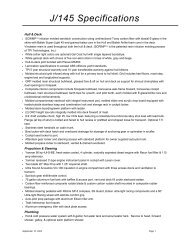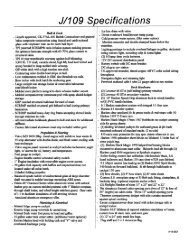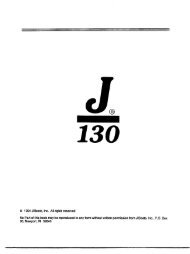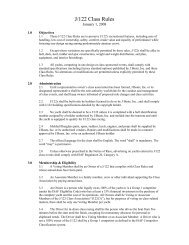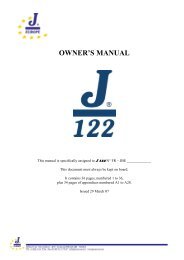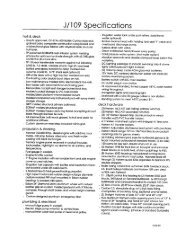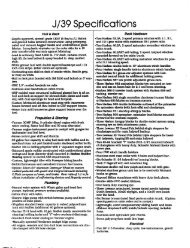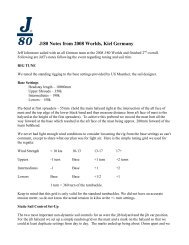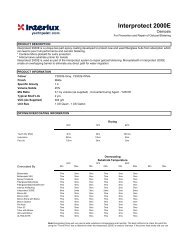J105 Owner Manual 2012.pdf - J/Owners
J105 Owner Manual 2012.pdf - J/Owners
J105 Owner Manual 2012.pdf - J/Owners
You also want an ePaper? Increase the reach of your titles
YUMPU automatically turns print PDFs into web optimized ePapers that Google loves.
J/105 <strong>Owner</strong> Guide ...................................................................................................................................................................................................................................................... 46 <br />
Appendix <br />
APPENDIX A: Best Practices – Boat Inspection <br />
J Boats has compiled, with the help of several industry experts, the following “best practices” <br />
inspection, maintenance and use guide for J/Boat owners. We urge each owner to read carefully <br />
the recommendations, to proactively and periodically inspect all critical components of your <br />
boat, and to contact anyone in the J/Boats network of dealers, builders and class associations if <br />
you need any assistance. <br />
Inspection Overview <br />
Considering the typical high-‐frequency use seen by many J/Boats, at a minimum, we recommend <br />
that owners have their boats inspected on an annual basis and that a professional survey be done <br />
every five years. An inspection should include a detailed review of the high-‐load areas, such as <br />
the rudder and keel attachments, rigging terminals, structural bulkheads, keel floors, mast step, <br />
mast partners, steering systems, mast and boom fittings, lifelines, etc. Inspection should also <br />
include identifying any possible leaks, including thru-‐hull fittings, as well as identifying worn <br />
rigging and hardware. Additional inspections/surveys should be performed immediately after <br />
any instances of grounding, collision, and/or extreme weather sailing. <br />
The American Bureau of Shipping (A.B.S.) calls for a detailed inspection every two years and a <br />
professional survey every 6 years (see Appendix B for details) following new construction. <br />
According to Carter Gowrie of the Gowrie Group, most insurance companies mandate a <br />
professional survey for boats at 10 years. A survey may indicate a structural or safety issue that <br />
an owner needs to address in order to continue insurance coverage. For boats that haven’t <br />
changed hands (which usually triggers a pre-‐sale survey), it’s otherwise left entirely to the owner <br />
to determine when a survey should occur. <br />
Keels & Keel Floors <br />
Overview -‐ One of the most critical areas of a modern, fin-‐keeled composite boat is the keel and <br />
keel floor area. This is an area that absorbs incredible loads and enormous stress. <br />
Use Considerations <br />
Groundings -‐ after any grounding or collision with any underwater object, soft or hard, be sure to <br />
carefully inspect the keel, sump area and keel floors for any signs of cracking or weakness. This is <br />
best handled by a qualified marine surveyor. Even a seemingly minor grounding can weaken the <br />
overall structure, particularly if left un-‐repaired for any length of time and/or if the boat <br />
continues to sail without repairing. There have been cases where a moderate grounding revealed <br />
no visible damage (due to the bottom of the boat absorbing the impact and then returning to <br />
shape), only later to reveal the presence of fractured glass on the inner hull laminate just aft of <br />
the keel. Have repairs done by a professional yard with a follow-‐up survey. <br />
Trailering/ Hauling/ Poppets -‐ boats that are actively trailered can be subject to excessive stress <br />
and strain on the keel/hull joint. In fact, years of trailering alone can subject a keel/ hull joint to <br />
excessively sharp vertical accelerations that can cause significant wear and tear on any portion of <br />
the composite structure; including keel sump and keel floors.



